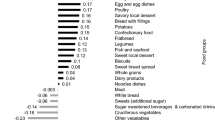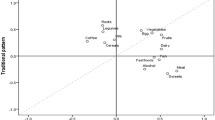Abstract
Background/objective:
The study was carried out to assess the relationship between nut consumption and lipid profile among Iranian adults.
Subject/methods:
The study was based on data from the Isfahan Healthy Heart Program across three counties in central Iran in 2007. A cross-sectional survey of 9660 randomly selected adults aged ⩾19 years were chosen based on sex, age and settlement distributions in each community. Nutritional behaviors were assessed by validated qualitative 48-item food frequency questionnaires, which covered regular intakes of four types of nuts: walnuts, almonds, pistachios and hazelnuts. Analysis of covariance and logistic regression tests were utilized to determine odds ratio (OR) 95% confidence interval of hyperlipidemia according to nut consumption patterns in unadjusted and three-adjusted models.
Results:
The results showed a significant link between high nut consumption and lower total cholesterol, triglyceride (TG), low-density lipoprotein cholesterol (LDL-C) levels and apo B/apo A ratio (P<0.05) in female subjects and lower TG, LDL-C and apoB/apoA ratio in male subjects (P<0.05). The frequency of nut consumption was inversely associated with dyslipidemia, especially for those who had consumed nuts ⩾4 times weekly (0.67 (0.57-0.79)). After adjusting for sex, age and other potential confounders, ORs increased enormously. Except for low apo A and high LDL-C, more frequent nut consumption (4⩽ times per week) had a significant inverse effect on other dyslipidemia risk factors in all four models.
Conclusions:
We concluded that frequent consumption of nuts, particularly ⩾4 times a week, may result in lower dyslipidemia occurrences and may exert cardioprotective effects.
This is a preview of subscription content, access via your institution
Access options
Subscribe to this journal
Receive 12 print issues and online access
$259.00 per year
only $21.58 per issue
Buy this article
- Purchase on Springer Link
- Instant access to full article PDF
Prices may be subject to local taxes which are calculated during checkout
Similar content being viewed by others
References
Yusuf S, Reddy S, Ounpuu S, Anand S . Global burden of cardiovascular diseases: part II: variations in cardiovascular disease by specific ethnic groups and geographic regions and prevention strategies. Circulation 2001; 104: 2855–2864.
Ros E, Mataix J . Fatty acid composition of nuts—implications for cardiovascular health. Br J Nutr 2006; 96 (Suppl 2), S29–S35.
Lopez-Uriarte P, Bullo M, Casas-Agustench P, Babio N, Salas-Salvado J . Nuts and oxidation: a systematic review. Nutr Rev 2009; 67: 497–508.
Megias-Rangil I, Garcia-Lorda P, Torres-Moreno M, Bullo M, Salas-Salvado J . [Nutrient content and health effects of nuts]. Arch Latinoam Nutr 2004; 54 (2 Suppl 1), 83–86.
Fung TT, McCullough ML, Newby PK, Manson JE, Meigs JB, Rifai N et al. Diet-quality scores and plasma concentrations of markers of inflammation and endothelial dysfunction. Am J Clin Nutr 2005; 82: 163–173.
Ros E . Nuts and novel biomarkers of cardiovascular disease. Am J Clin Nutr 2009; 89: 1649S–1656SS.
Sabate J, Oda K, Ros E . Nut consumption and blood lipid levels: a pooled analysis of 25 intervention trials. Arch Intern Med 2010; 170: 821–827.
Nash SD, Nash DT . Nuts as part of a healthy cardiovascular diet. Curr Atheroscler Rep 2008; 10: 529–535.
Nash SD, Westpfal M . Cardiovascular benefits of nuts. Am J Cardiol 2005; 95: 963–965.
Nus M, Ruperto M, Sanchez-Muniz FJ . [Nuts, cardio and cerebrovascular risks. A Spanish perspective]. Arch Latinoam Nutr 2004; 54: 137–148.
Rudkowska I . Functional foods for health: focus on diabetes. Maturitas 2009; 62: 263–269.
Sabate J, Ang Y . Nuts and health outcomes: new epidemiologic evidence. Am J Clin Nutr 2009; 89: 1643S–1648SS.
Kelly JH, Sabate J . Nuts and coronary heart disease: an epidemiological perspective. Br J Nutr 2006; 96 (Suppl 2), S61–S67.
Sarrafzadegan N, Baghaei AM, Sadri GH, Kelishadi R, Malekafzali H, Boshtam M et al. Isfahan Healthy Heart Program: evaluation of comprehensive, community-based interventions for non-communicable disease. Prevention Control J 2006; 2: 73–84.
Sarraf-Zadegan N, Sadri G, Malek Afzali H, Baghaei M, Mohammadi Fard N, Shahrokhi S et al. Isfahan Healthy Heart Programme: a comprehensive integrated community-based programme for cardiovascular disease prevention and control. Design, methods and initial experience. Acta Cardiol 2003; 58: 309–320.
Mohammadifard N, Kelishadi R, Safavi M, Sarrafzadegan N, Sajadi F, Sadri GH et al. Effect of a community-based intervention on nutritional behaviour in a developing country setting: the Isfahan Healthy Heart Programme. Public Health Nutr 2009; 12: 1422–1430.
Leparki E, Nussel E . CINDI: Contrywide Integrated Non-Communicable Diseases Interventional Programme: protocol and Guidelines for monitoring and evaluation procedures. Berlin: Springer 1987: 73–82.
Warnick GR, Benderson J, Albers JJ . Dextran sulfate-Mg2+ precipitation procedure for quantitation of high-density-lipoprotein cholesterol. Clin Chem 1982; 28: 1379–1388.
Friedewald WT, Levy RI, Fredrickson DS . Estimation of the concentration of low-density lipoprotein cholesterol in plasma, without use of the preparative ultracentrifuge. Clin Chem 1972; 18: 499–502.
Expert Panel on Detection, Evaluation, And Treatment of High Blood Cholesterol In Adults. Executive summary of the third report of the National Cholesterol Education Program (NCEP) expert panel on detection, evaluation, and treatment of high blood cholesterol in adults (adult treatment panel III). JAMA 2001 16; 285: 2486–2497.
Schaefer EJ, Lamon-Fava S, Cohn SD, Schaefer MM, Ordovas JM, Castelli WP et al. Effects of age, gender, and menopausal status on plasma low density lipoprotein cholesterol and apolipoprotein B levels in the Framingham Offspring Study. J Lipid Res 1994; 35: 779–792.
Carnevale Schianca GP, Pedrazzoli R, Onolfo S, Colli E, Cornetti E, Bergamasco L et al. ApoB/apoA-I ratio is better than LDL-C in detecting cardiovascular risk. Nutr Metab Cardiovasc Dis 2011; 21: 406–411.
NIH. The Practical Guide Identification, Evaluation and Treatment of Overweight and Obesity in Adults. NIH Publication, 2000.
USDA. USDA Nutrition Evidence Library 2010, Available from http://www.nel.gov/evidence.cfm?evidence_summary_id=250217.
Mukuddem-Petersen J, Oosthuizen W, Jerling JC . A systematic review of the effects of nuts on blood lipid profiles in humans. J Nutr 2005; 135: 2082–2089.
Li TY, Brennan AM, Wedick NM, Mantzoros C, Rifai N, Hu FB . Regular consumption of nuts is associated with a lower risk of cardiovascular disease in women with type 2 diabetes. J Nutr 2009; 139: 1333–1338.
Rajaram S, Haddad EH, Mejia A, Sabate J . Walnuts and fatty fish influence different serum lipid fractions in normal to mildly hyperlipidemic individuals: a randomized controlled study. Am J Clin Nutr 2009; 89: 1657S–1663SS.
Sheridan MJ, Cooper JN, Erario M, Cheifetz CE . Pistachio nut consumption and serum lipid levels. J Am Coll Nutr 2007; 26: 141–148.
Sabate J, Wien M . Nuts, blood lipids and cardiovascular disease a pooled analysis of 25 intervention trials. Asia Pac J Clin Nutr 2010; 19: 131–136.
Banel DK, Hu FB . Effects of walnut consumption on blood lipids and other cardiovascular risk factors: a meta-analysis and systematic review. Am J Clin Nutr 2009; 90: 56–63.
Phung OJ, Makanji SS, White CM, Coleman CI . Almonds have a neutral effect on serum lipid profiles: a meta-analysis of randomized trials. J Am Diet Assoc 2009; 109: 865–873.
Gebauer SK, West SG, Kay CD, Alaupovic P, Bagshaw D, Kris-Etherton PM . Effects of pistachios on cardiovascular disease risk factors and potential mechanisms of action: a dose-response study. Am J Clin Nutr 2008; 88: 651–659.
Mercanligil SM, Arslan P, Alasalvar C, Okut E, Akgul E, Pinar A et al. Effects of hazelnut-enriched diet on plasma cholesterol and lipoprotein profiles in hypercholesterolemic adult men. Eur J Clin Nutr 2007; 61: 212–220.
Tey SL, Brown RC, Chisholm AW, Delahunty CM, Gray AR, Williams SM . Effects of different forms of hazelnuts on blood lipids and alpha-tocopherol concentrations in mildly hypercholesterolemic individuals. Eur J Clin Nutr 2011; 65: 117–124.
St-Onge MP, Bourque C, Jones PJ, Ross R, Parsons WE . Medium- versus long-chain triglycerides for 27 days increases fat oxidation and energy expenditure without resulting in changes in body composition in overweight women. Int J Obes Relat Metab Disord 2003; 27: 95–102.
Claesson AL, Holm G, Ernersson A, Lindstrom T, Nystrom FH . Two weeks of overfeeding with candy, but not peanuts, increases insulin levels and body weight. Scand J Clin Lab Invest 2009; 69: 598–605.
Berry SE, Tydeman EA, Lewis HB, Phalora R, Rosborough J, Picout DR et al. Manipulation of lipid bioaccessibility of almond seeds influences postprandial lipemia in healthy human subjects. Am J Clin Nutr 2008; 88: 922–929.
Mandalari G, Faulks RM, Rich GT, Lo Turco V, Picout DR, Lo Curto RB et al. Release of protein, lipid, and vitamin E from almond seeds during digestion. J Agric Food Chem 2008; 56: 3409–3416.
Cassady BA, Hollis JH, Fulford AD, Considine RV, Mattes RD . Mastication of almonds: effects of lipid bioaccessibility, appetite, and hormone response. Am J Clin Nutr 2009; 89: 794–800.
Frecka JM, Hollis JH, Mattes RD . Effects of appetite, BMI, food form and flavor on mastication: almonds as a test food. Eur J Clin Nutr 2008; 62: 1231–1238.
Blomhoff R, Carlsen MH, Andersen LF, Jacobs DR . Health benefits of nuts: potential role of antioxidants. Br J Nutr 2006; 96 (Suppl 2), S52–S60.
Brown RC, Tey SL, Chisholm AW, Delahunty CM, Gray AR, Williams SM . Effects of different forms of hazelnuts on blood lipids and alpha-tocopherol concentrations in mildly hypercholesterolemic individuals. Eur J Clin Nutr 2011; 65: 117–124.
Escurriol V, Cofan M, Serra M, Bullo M, Basora J, Salas-Salvado J et al. Serum sterol responses to increasing plant sterol intake from natural foods in the Mediterranean diet. Eur J Nutr 2009; 48: 373–382.
Segura R, Javierre C, Lizarraga MA, Ros E . Other relevant components of nuts: phytosterols, folate and minerals. Br J Nutr 2006; 96 (Suppl 2), S36–S44.
Garrido I, Monagas M, Gomez-Cordoves C, Bartolome B . Polyphenols and antioxidant properties of almond skins: influence of industrial processing. J Food Sci 2008; 73: C106–C115.
Sari I, Baltaci Y, Bagci C, Davutoglu V, Erel O, Celik H et al. Effect of pistachio diet on lipid parameters, endothelial function, inflammation, and oxidative status: a prospective study. Nutrition 2010; 26: 399–404.
Acknowledgements
This program was conducted by the Isfahan Cardiovascular Research Center (ICRC) (a WHO-collaborating center) in collaboration with Isfahan Provincial Health Office. Both are affiliated with the Isfahan University of Medical Sciences. The program was supported by a grant (no. 31309304) from the Iranian Budget and Planning Organization, as well as the Deputy for Health of the Iranian Ministry of Health and Medical Education and the Iranian Heart Foundation. We are thankful to the large team of ICRC and Isfahan Provincial Health Office as well as collaborators from Najaf-Abad Health Office and Arak University of Medical Sciences.
Author information
Authors and Affiliations
Corresponding author
Ethics declarations
Competing interests
The authors declare no conflict of interest.
Rights and permissions
About this article
Cite this article
Askari, G., Yazdekhasti, N., Mohammadifard, N. et al. The relationship between nut consumption and lipid profile among the Iranian adult population; Isfahan Healthy Heart Program. Eur J Clin Nutr 67, 385–389 (2013). https://doi.org/10.1038/ejcn.2013.21
Received:
Revised:
Accepted:
Published:
Issue Date:
DOI: https://doi.org/10.1038/ejcn.2013.21
Keywords
This article is cited by
-
Inhibition of browning via aqueous gel solution of Aloe vera: a new method for preserving fresh fruits as a case study on fresh kernels of Persian walnut
Journal of Food Science and Technology (2022)
-
Weight loss with a modified Mediterranean-type diet using fat modification: a randomized controlled trial
European Journal of Clinical Nutrition (2015)
-
Inverse association between the frequency of nut consumption and obesity among Iranian population: Isfahan Healthy Heart Program
European Journal of Nutrition (2015)



